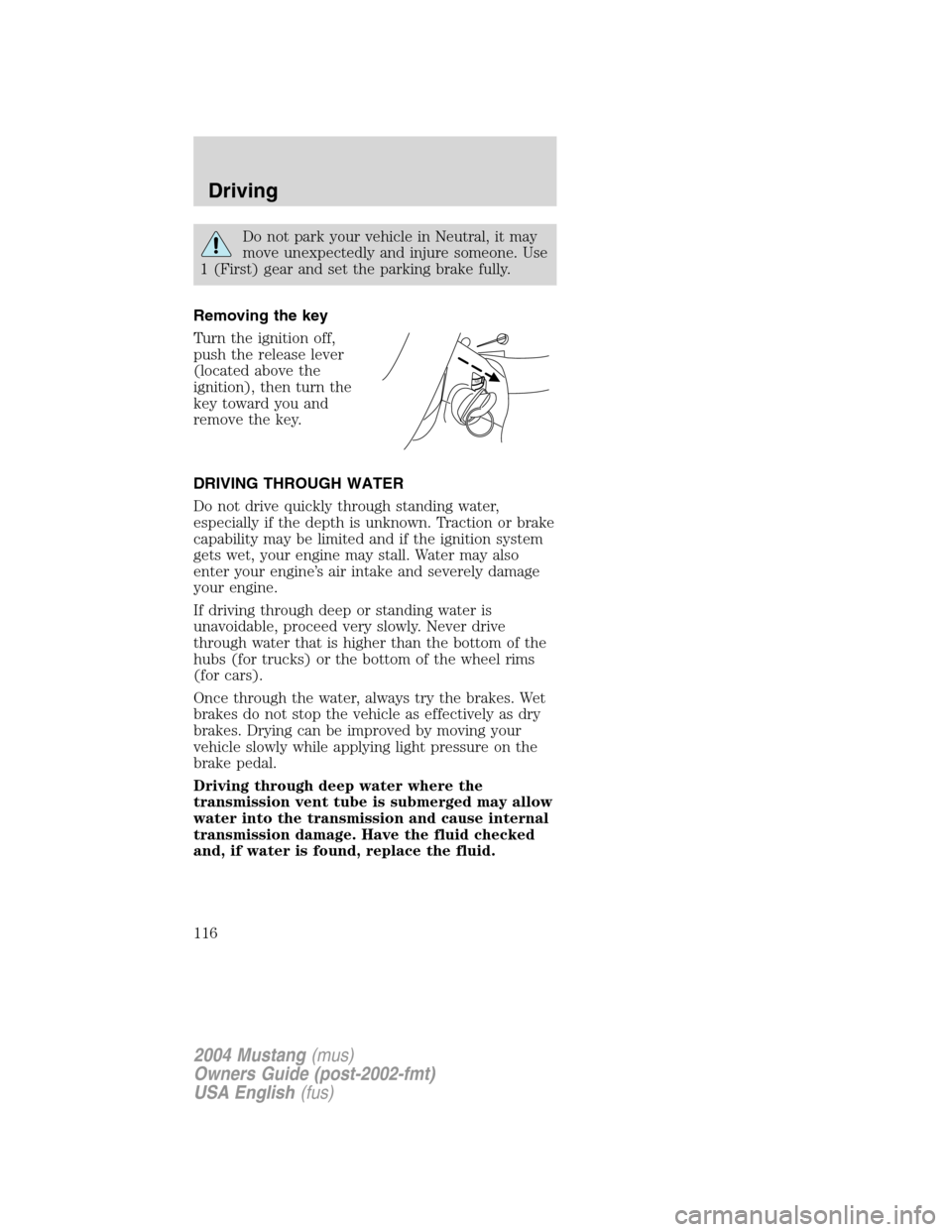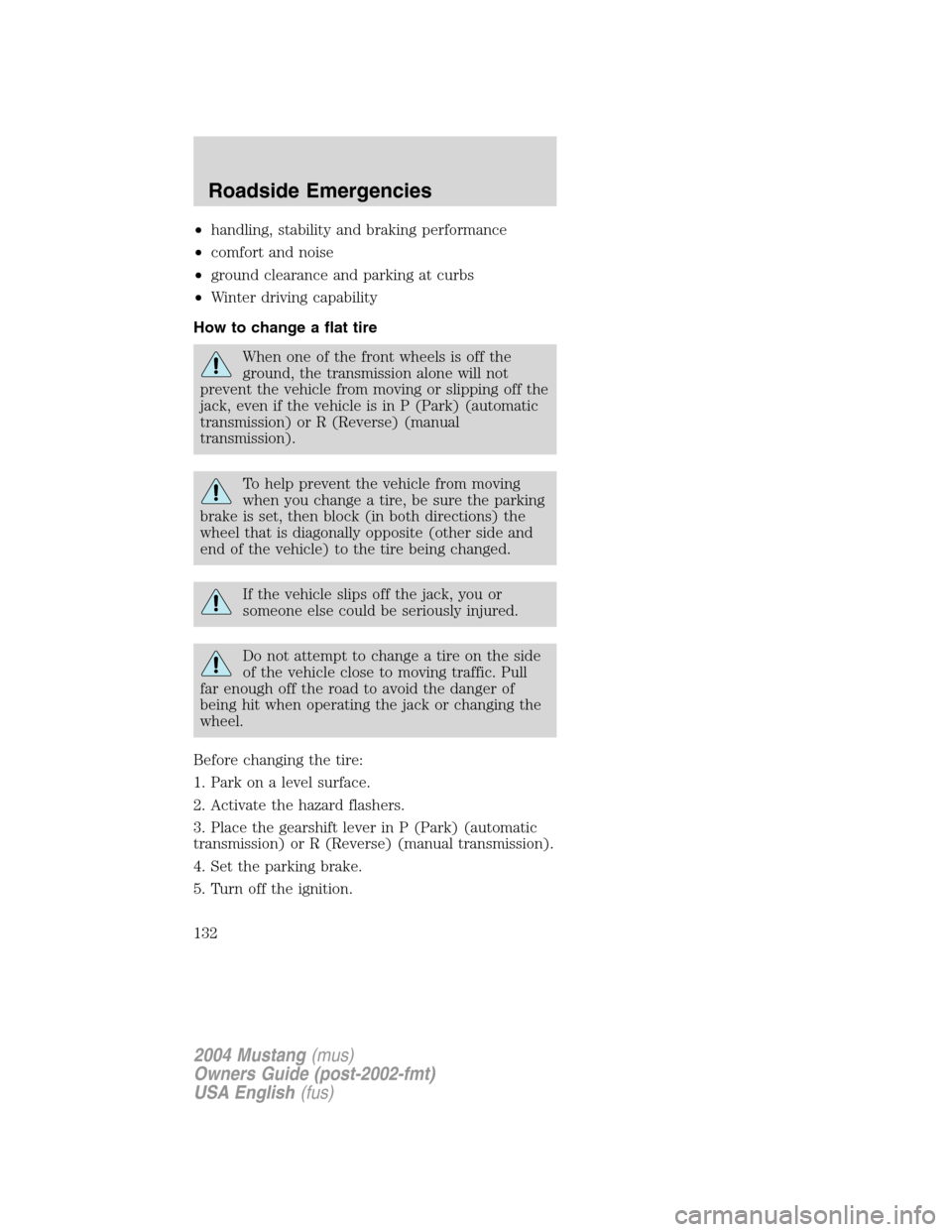Page 108 of 240

system is off, the indicator will be illuminated. If a
system fault is detected while the traction control
system in on, the indicator lamp on the traction
control switch will be illuminated and your vehicle
should be serviced.
Aggressive driving in any road conditions
can cause you to lose control of your vehicle
increasing the risk of severe personal injury or
property damage. The occurrence of a Traction
Control�event is an indication that at least some
of the tires have exceeded their ability to grip the
road; this may lead to an increased risk of loss of
vehicle control, vehicle rollover, personal injury
and death. If you experience a severe road event,
SLOW DOWN.
TRACTION-LOK AXLE (IF EQUIPPED)
This axle provides added traction on slippery
surfaces, particularly when one wheel is on a poor
traction surface. Under normal conditions, the
Traction-Lok axle functions like a standard rear axle.
Extended use of other than the manufacturer’s
specified size tires on a Traction-Lok rear axle could
result in a permanent reduction in effectiveness.
This loss of effectiveness does not affect normal
driving and should not be noticeable to the driver.
AUTOMATIC TRANSMISSION OPERATION
(IF EQUIPPED)
Brake-shift interlock
This vehicle is equipped with a brake-shift interlock
feature that prevents the gearshift lever from being
moved from P (Park) when the ignition is in the ON
position unless the brake pedal is depressed.
If you cannot move the gearshift lever out of P
(Park) with ignition in the ON position and the
brake pedal depressed:
1. Apply the parking brake, turn ignition key to
LOCK, then remove the key.
2004 Mustang(mus)
Owners Guide (post-2002-fmt)
USA English(fus)
Driving
108
Page 109 of 240

2. Insert the key and turn it to OFF.Apply the
brake pedal and shift to N (Neutral).
When the key is in the ignition and in the
OFF position, the automatic transmission
shift lever can be moved from the P (Park)
position without the brake pedal depressed. To
avoid unwanted vehicle movement, always set the
parking brake.
3. Start the vehicle.
If it is necessary to use the above procedure to
move the gearshift lever, it is possible that a fuse
has blown or the vehicle’s brakelamps are not
operating properly. Refer toFuses and relaysin the
Roadside emergencieschapter.
Do not drive your vehicle until you verify
that the brakelamps are working.
Always set the parking brake fully and make
sure the gearshift is latched in P (Park).
Turn the ignition to the LOCK position and remove
the key whenever you leave your vehicle.
If the parking brake is fully released, but the
brake warning lamp remains illuminated, the
brakes may not be working properly. See your
dealer or a qualified service technician.
Driving with an automatic overdrive
transmission with console gearshift and O/D off
switch
Your transmission is equipped with an adaptive
learning strategy found in the vehicle computer. This
feature is designed to increase durability and
provide consistent shift feel over the life of the
vehicle. A new vehicle or transmission may have firm
and/or soft shifts. This operation is considered
2004 Mustang(mus)
Owners Guide (post-2002-fmt)
USA English(fus)
Driving
109
Page 111 of 240
Understanding the gearshift positions of the
4–speed automatic transmission
P (Park)
This position locks the transmission and prevents
the rear wheels from turning.
To put your vehicle in gear:
•Start the engine
•Depress the brake pedal
•Move the gearshift lever into the desired gear
To put your vehicle in P (Park):
•Come to a complete stop
•Move the gearshift lever and securely latch it in P
(Park)
Always set the parking brake fully and make
sure the gearshift is latched in P (Park).
Turn the ignition to the LOCK position and remove
the key whenever you leave your vehicle.
2004 Mustang(mus)
Owners Guide (post-2002-fmt)
USA English(fus)
Driving
111
Page 115 of 240

a standstill while waiting on a hill. These actions will
reduce the life of the clutch.
Recommended shift speeds
Do not downshift into 1 (First) when your
vehicle is moving faster than 24 km/h (15 mph).
This will damage the clutch.
Upshift according to the following chart:
Upshifts when accelerating (recommended for best
fuel economy)
Shift from:
1 - 2 18 km/h (11 mph)
2 - 3 31 km/h (19 mph)
3 - 4 48 km/h (30 mph)
4 - 5 64 km/h (40 mph)
Reverse
1. Make sure that your vehicle is at a complete stop
before you shift into R (Reverse). Failure to do so
may damage the transmission.
2. Move the gearshift lever into the neutral position
and wait at least three seconds before shifting into R
(Reverse).
•The gearshift lever can only be moved into R
(Reverse) by moving it from left of 3 (Third) and
4 (Fourth) before shifting into R (Reverse). This
is a lockout feature that protects the transmission
from accidentally being shifted into R (Reverse)
from 5 (Overdrive).
Parking your vehicle
1. Apply the brake and shift into the neutral
position.
2. Fully apply the parking brake, then shift into 1
(First).
3. Turn the ignition off.
2004 Mustang(mus)
Owners Guide (post-2002-fmt)
USA English(fus)
Driving
115
Page 116 of 240

Do not park your vehicle in Neutral, it may
move unexpectedly and injure someone. Use
1 (First) gear and set the parking brake fully.
Removing the key
Turn the ignition off,
push the release lever
(located above the
ignition), then turn the
key toward you and
remove the key.
DRIVING THROUGH WATER
Do not drive quickly through standing water,
especially if the depth is unknown. Traction or brake
capability may be limited and if the ignition system
gets wet, your engine may stall. Water may also
enter your engine’s air intake and severely damage
your engine.
If driving through deep or standing water is
unavoidable, proceed very slowly. Never drive
through water that is higher than the bottom of the
hubs (for trucks) or the bottom of the wheel rims
(for cars).
Once through the water, always try the brakes. Wet
brakes do not stop the vehicle as effectively as dry
brakes. Drying can be improved by moving your
vehicle slowly while applying light pressure on the
brake pedal.
Driving through deep water where the
transmission vent tube is submerged may allow
water into the transmission and cause internal
transmission damage. Have the fluid checked
and, if water is found, replace the fluid.
PUSH
2004 Mustang(mus)
Owners Guide (post-2002-fmt)
USA English(fus)
Driving
116
Page 124 of 240

HAZARD FLASHER
The hazard flasher is
located on the steering
column, just behind the
steering wheel. The
hazard flashers will
operate when the
ignition is in any
position or if the key is
not in the ignition.
Push in the flasher control and all front and rear
direction signals will flash. Press the flasher control
again to turn them off. Use it when your vehicle is
disabled and is creating a safety hazard for other
motorists.
Note:With extended use, the flasher may run down
your battery.
FUEL PUMP SHUT-OFF SWITCH
FUEL
RESET
This device stops the electric fuel pump from
sending fuel to the engine when your vehicle has
had a substantial jolt.
After an accident, if the engine cranks but does not
start, this switch may have been activated.
The fuel pump shut-off
switch is located on
the left side of the
trunk between the left
rear tail light and the
trunk liner, and to the
left of the hole in the
trunk liner
To reset the switch:
1. Turn the ignition OFF.
2. Check the fuel system for leaks.
3. If no leaks are apparent, reset the switch by
pushing in on the reset button.
4. Turn the ignition ON.
2004 Mustang(mus)
Owners Guide (post-2002-fmt)
USA English(fus)
Roadside Emergencies
124
Page 129 of 240
The high-current fuses are coded as follows.
Fuse/Relay
LocationFuse Amp
RatingPower Distribution Box
Description
Relay 1—Fog lamp interrupt
Relay 2—Interval wiper
Relay 3—Wiper HI/LO
Relay 4—Starter
Relay 5—Fog lamps
1 50A** (4.6L),
30A CB
(3.8L)Electric cooling fan motor
2 30A** Headlamps
3 40A** Starter motor relay, Ignition
switch
4 40A** Ignition switch
5 40A** Ignition switch
6 40A** Instrument cluster,
Powertrain Control Module
(PCM)
7—Not used
8 50A** Anti-lock Brake System
(ABS) module
9 20A** Auxiliary power point
10 30A** Parklamps
11 30A** Rear window defrost control
12 40A** Power locks
2004 Mustang(mus)
Owners Guide (post-2002-fmt)
USA English(fus)
Roadside Emergencies
129
Page 132 of 240

•handling, stability and braking performance
• comfort and noise
• ground clearance and parking at curbs
• Winter driving capability
How to change a flat tire
When one of the front wheels is off the
ground, the transmission alone will not
prevent the vehicle from moving or slipping off the
jack, even if the vehicle is in P (Park) (automatic
transmission) or R (Reverse) (manual
transmission).
To help prevent the vehicle from moving
when you change a tire, be sure the parking
brake is set, then block (in both directions) the
wheel that is diagonally opposite (other side and
end of the vehicle) to the tire being changed.
If the vehicle slips off the jack, you or
someone else could be seriously injured.
Do not attempt to change a tire on the side
of the vehicle close to moving traffic. Pull
far enough off the road to avoid the danger of
being hit when operating the jack or changing the
wheel.
Before changing the tire:
1. Park on a level surface.
2. Activate the hazard flashers.
3. Place the gearshift lever in P (Park) (automatic
transmission) or R (Reverse) (manual transmission).
4. Set the parking brake.
5. Turn off the ignition.
2004 Mustang (mus)
Owners Guide (post-2002-fmt)
USA English (fus)
Roadside Emergencies
132